A Brief History
Before reggaeton was called reggaeton, it went by the humbler, less marketable “Spanish Reggae” or Reggae en Español. Traveling along mass media circuits as well as diasporic networks, Jamaican popular music spread around the world in the 1960s and 70s. Reggae arrived in places like Panama and Puerto Rico as quickly as it reached more traditional centers of migration, such as London and New York. In the case of Panama, which proudly claims reggaeton as its own, Afro-Panamanians — many of them the descendents of Jamaican migrant workers — had been performing and recording Spanish-language reggae since at least the 1970s. Tens of thousands of Jamaicans moved to Central America in search of work in the late 19th and early 20th centuries. Having contributed to the building of the Canal, many settled on Panama’s Caribbean coast, maintaining connections to Jamaica even as some adopted Spanish as their native tongue. By the late 1980s and early ’90s, Afro-Panamanian artists such as El General and Nando Boom were making waves by adapting the latest dancehall reggae hits for Hispanic audiences, loosely (and sometimes closely) translating the lyrics and often singing the same, recognizable melodies over the original, Jamaican-produced riddims.
 These musical translations found favor not simply in Panama but, crucially, in such pan-Latino, pan-Caribbean centers as NYC, where Panamanians and Jamaicans mingled with Puerto Ricans, Cubans, Dominicans, and African-Americans, and where such hybrid, resonant styles as Spanish-language reggae could find a receptive audience. In Puerto Rico, where rappers such as Vico C had pioneered Spanish-language hip-hop, these Jamaican-inflected “translations” of popular dancehall songs had wide appeal. Dancehall reggae had already established a strong following in Puerto Rico in its own right by the early ’90s, as popular songs by Jamaican deejays such as Shabba Ranks, Cutty Ranks, and Chaka Demus & Pliers helped to redefine the sound of contemporary club music. It was, in fact, a Shabba Ranks song, “Dem Bow,” produced by Bobby Digital, which would lay the foundation for what became known as reggaeton. The underlying instrumental — i.e., riddim — for “Dem Bow,” a minimalist production with catchy percussion, became an overwhelming favorite in Puerto Rican freestyle sessions, to the point where, for a time, Spanish-language reggae in Puerto Rico was simply called Dembow. Vocalists drew on a variety of styles, borrowing from dancehall, hip-hop, and various Latin musical traditions and creating a distinctive synthesis. By the mid-90s, a catchier tag came along, and reggaeton began to describe what was emerging as far and away the most popular music for lower-class Puerto Rican youth, at home and in the United States.
These musical translations found favor not simply in Panama but, crucially, in such pan-Latino, pan-Caribbean centers as NYC, where Panamanians and Jamaicans mingled with Puerto Ricans, Cubans, Dominicans, and African-Americans, and where such hybrid, resonant styles as Spanish-language reggae could find a receptive audience. In Puerto Rico, where rappers such as Vico C had pioneered Spanish-language hip-hop, these Jamaican-inflected “translations” of popular dancehall songs had wide appeal. Dancehall reggae had already established a strong following in Puerto Rico in its own right by the early ’90s, as popular songs by Jamaican deejays such as Shabba Ranks, Cutty Ranks, and Chaka Demus & Pliers helped to redefine the sound of contemporary club music. It was, in fact, a Shabba Ranks song, “Dem Bow,” produced by Bobby Digital, which would lay the foundation for what became known as reggaeton. The underlying instrumental — i.e., riddim — for “Dem Bow,” a minimalist production with catchy percussion, became an overwhelming favorite in Puerto Rican freestyle sessions, to the point where, for a time, Spanish-language reggae in Puerto Rico was simply called Dembow. Vocalists drew on a variety of styles, borrowing from dancehall, hip-hop, and various Latin musical traditions and creating a distinctive synthesis. By the mid-90s, a catchier tag came along, and reggaeton began to describe what was emerging as far and away the most popular music for lower-class Puerto Rican youth, at home and in the United States.
Reggaeton isn’t only a snappy marketing label, it also served to distinguish a uniquely Puerto Rican style from such precursors as Latin hip-hop and Reggae en Español. In this sense, the music’s Panamanian roots notwithstanding, Puerto Rico does have a special claim to reggaeton. It was but a skip and a jump before it found widespread support among Hispanic youth in the US. Circulating via channels of migration and — increasingly and importantly — on the Internet, reggaeton soon became the sound of a generation, finding footholds in a number of US cities with significant Latino populations.
With a building presence in clubs and on radio in New York and Miami, a couple breakthrough hits were all that reggaeton needed to introduce its sensuous sounds to the mainstream. With its Spanglish verses and overt pan-Latino pride, New York-based rapper N.O.R.E.’s “Oye Mi Canto,” featuring Nina Sky and reggaeton stalwarts Tego Calderon and Daddy Yankee, explicitly pushed and promoted reggaeton to what had become — thanks to 2003’s banner year for dancehall — a reggae-friendly audience. Climbing the charts soon thereafter, Daddy Yankee’s “Gasolina” became the kind of pop anthem that no one could ignore (or avoid), convincing hip-hop moguls from Lil Jon to Diddy to get in on the action. In the last few years, on the heels of these hits, reggaeton has spread across the US and the globe, but especially in Latin America, where the music’s transnationalism, for all its power to animate expressions of pan-Latino identity, sometimes comes into conflict with national identities, as when Puerto Ricans and Panamanians debate claims over origins, or when Cuban reggaeton producers bemoan the dominance of Puerto Rican style
ADVERTISEMENT
 |